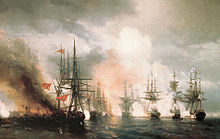Battle of Sinop
| Battle of Sinop | |||||||
|---|---|---|---|---|---|---|---|
| Part of the Crimean War | |||||||
 The Battle of Sinop, by Ivan Aivazovsky. Oil on Canvas XIX cent. | |||||||
| |||||||
| Belligerents | |||||||
|
|
| ||||||
| Commanders and leaders | |||||||
|
|
| ||||||
| Strength | |||||||
|
6 ships of the line, 2 frigates, 3 steamers |
Land: unknown land forces Sea: 7 frigates, 3 corvettes, 2 steamers | ||||||
| Casualties and losses | |||||||
|
37 killed, 233 wounded, ~3 ships of the line damaged |
~3,000 killed or wounded, 1 frigate sunk, 1 steamer sunk, 6 frigates grounded, 3 corvettes grounded, ~2 shore batteries destroyed | ||||||

The Battle of Sinop, or the Battle of Sinope, took place on 30 November 1853 at Sinop, a sea port in northern Anatolia, when Imperial Russian warships struck and annihilated a patrol force of Ottoman ships anchored in the harbor. The battle was part of the Crimean War, and a contributory factor in bringing France and Britain into the conflict.
Background
Fighting at sea between Imperial Russia and the Ottoman Empire had been going on for weeks, and the Ottomans had sent several squadrons into the Black Sea to patrol. One of these squadrons, under Osman Pasha, ended up at Sinope, joining the frigate Kaid Zafer which had been part of an earlier patrol, and being joined by the steam frigate Taif from a smaller squadron. The Ottomans had wanted to send ships of the line to Sinope, but the British ambassador in Constantinople, Viscount Stratford de Redcliffe, had objected to this plan, and only frigates were sent.
Battle

The Russians were led by Admiral Pavel Nakhimov, who decided with his officers that they would attack the Ottoman fleet which took shelter from a storm at Sinop. Strengthened by the squadron of Rear-Admiral Fyodor Novosilsky, Nakhimov consolidated over 700 cannons in six ships of the line, two frigates and three armed steamers. The Ottoman forces included seven frigates, three corvettes and two armed steamers. The Russians planned to deploy their ships in two columns where they would advance to within close range of the enemy vessels before dropping anchor and opening fire. Under Admiral Nakhimov's command, the eighty-four gun ship Imperatritsa Maria was the first to engage when she fired on the 44-gun Ottoman flagship Auni Allah. After about thirty minutes of deadly combat the Ottoman frigate was full of shot-holes and ran aground when her cable was cut. Imperatritsa Maria then attacked the forty-four gun frigate Fazli Allah which caught fire and grounded. Meanwhile, the other Russian ships engaged the Nizamie and Damiad, which were grounded. The Ottoman frigate Navek Bakhri exploded and sank along with the corvette Guli Sephid. Only one Ottoman vessel, the twelve gun steamer Taif, managed to escape the battle while all the others were either sunk or purposely run ashore to prevent sinking. She fled to Constantinople and arrived on 2 December where she informed the Ottoman government of the defeat at Sinop. Once the enemy fleet was destroyed the Russians engaged Ottoman shore batteries and destroyed them. During the fighting thirty-seven Russians were killed and 233 were wounded; at least three of the ships of the line were damaged. Ottoman forces lost over 3,000 men killed or wounded and their leader Osman Pasha was captured.

This attack provided France and the United Kingdom with the justification for declaring war on Russia in early 1854 in support of the Ottoman Empire.
Order of battle
Russian Empire
- Veliky Knyaz Konstantin, ship of the line, 120 guns
- Tri Sviatitelia, ship of the line, 120 guns
- Parizh, 120 guns, ship of the line, transferred flagship
- Imperatriitsa Maria, ship of the line, 84 guns, flagship
- Chesma, ship of the line, 84 guns
- Rostislav, ship of the line, 84 guns
- Kulevtcha, frigate, 54 guns
- Kagul, frigate, 44 guns
- Odessa, steamer, 4 guns
- Krym, steamer, 4 guns
- Khersones, steamer, 4 guns
Ottoman Empire

- Avni Illah, frigate, 44 guns (grounded)
- Fazl Illah, frigate, 44 guns (originally the Russian Rafail, captured during the war of 1828-29) (inflamed, grounded)
- Nizamieh, frigate, 62 guns (grounded after losing two masts)
- Nessin Zafer, frigate, 60 guns (grounded after had anchor chain broken)
- Navek Bahri, frigate, 58 guns (exploded)
- Damiat, frigate, 56 guns (Egyptian) (grounded)
- Kaid Zafer, frigate, 54 guns (grounded)
- Nejm Fishan, corvette, 24 guns
- Feyz Mabud, corvette, 24 guns (grounded)
- Kel Safid, corvette, 22 guns (exploded)
- Taif, steamer, 12 guns (retreated to Istanbul)
- Erkelye, steamer, 10 guns
References
This article includes a list of references, related reading, or external links, but its sources remain unclear because it lacks inline citations. (December 2010) |
- www.denizmuzeleri.tsk.tr/idmk.
- Naval wars in the Levant 1559–1853 (1952) - R. C. Anderson ISBN 1-57898-538-2
- BAŞ,Ersan:Çeşme, Navarin, Sinop Baskınları ve Sonuçları (Cesme, Navarin, Sinop Rates and Results) Türk Deniz Harp Tarihinde İz Bırakan Gemiler, Olaylar ve Şahıslar Sayı: 8, Piri Reis Araştırma Merkezi Yayını, Deniz Basımevi, 2007, İstanbul, ISBN 975-409-452-7.
External links
